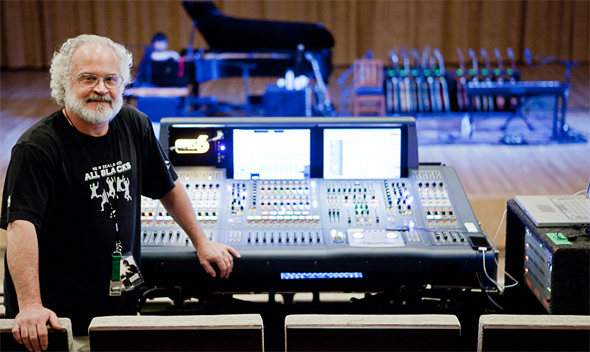I’ve made a living for 30 years as a recording mix engineer, a live mix engineer, and more recently, as a record producer.
In addition to engineering and co-producing a number of records – including multiple Grammy Award nominees – that were recorded live to multi-track while I was mixing front of house, I also edited, mixed, and assembled the final products.
The changes in the technology and the industry the past 15 years or so have been astounding, and I’m proud to have been at the forefront of those changes, making records and mixing the house with the finest talent and latest equipment available.
I’m also very fortunate to have had very successful careers in both the live and recording worlds. This was once an impressive statement, and not something many people could claim.
But now, the line between studio and live is getting increasingly blurry, with many engineers acting in both roles for an artist. There has been a fundamental change in how music is recorded and distributed, a change that requires a wider skill-set among engineers who hope to remain competitive into the future.
Live engineers are now often required to make high-quality multitrack recordings at the same time as they’re mixing the show, and some artists will even make a mix available to the audience soon after the performance.
In an ideal world, there is an engineer whose job description includes nothing but the recording and/or distribution of these shows, but this is not always the case, and live mix engineers are increasingly finding their workloads increased by multitrack recording demands.
Accomplished recording engineers and equally accomplished live engineers used to have a great deal of animosity towards and disdain for each other. This was particularly evident on those rare occasions when their worlds intersected. Live guys grumbled that the “studio guy” had no idea how to tune a PA and no understanding of the exegeses and uncontrollable variables of the live environment. Studio guys remarked about the crude tools and the less-than-perfect acoustics – as if that would change something.
Challenging Assumptions
In the past, a whole separate class of engineer and facility (the “mobile recording studio”) existed to facilitate the on-any-location recording of live performances for albums, videos, and re-broadcast. Men like Kooster McAllister, Guy Charbonneau, Dave Hewitt, Randy Ezratty, and others filled a need for high quality multitrack recording; blending studio audio sensibilities with the “get ‘er done” work ethic of live engineering. The drawback was that those facilities were expensive to build and to operate, and nobody could really afford to make quality multitrack recordings of every show.
In 1977, Jackson Browne challenged that assumption and took a Studer A-80 24-track recorder and his studio engineer Greg Ladanyi on the road with the idea that every show would be recorded. The tape deck was set up onstage and fed directly from a split. Greg would set levels by adjusting the tape machine’s input gain control, and the stage set was constructed to accommodate changing reels of tape every 15 minutes. In addition to the live multitrack, they were also making live to 2-track recordings in hotel rooms, tour buses, and dressing rooms.
Most everyone who witnessed this thought it was lunacy, but it resulted in the groundbreaking live album Running On Empty. While the method was incredibly primitive by today’s standards, and even somewhat primitive by the standards of the day, it was a seminal moment in the history of live recording. The artist had freed himself from the limitations and expense of the “mobile studio,” making a record of new songs on the road (previously unheard of) without the need to endure the inevitable disruptions incurred by booking a “proper” location recording studio.




















